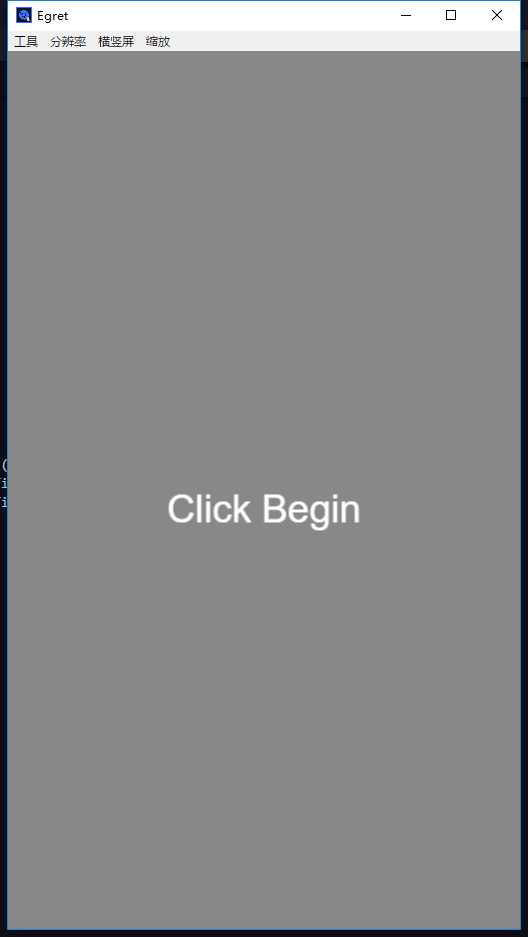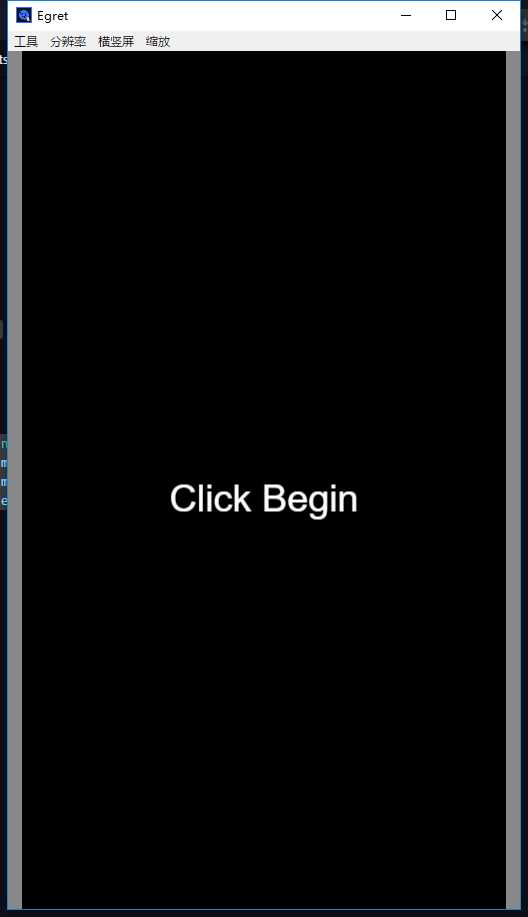打开 Egret Wing,新建一个Egret游戏项目,然后删掉默认生成的createGameScene方法里面的东西
然后新建一个BeginScene.ts的文件,作为我们的游戏的第一个场景
1 class BeginScene extends egret.DisplayObjectContainer { 2 public constructor() { 3 super(); 4 this.addEventListener(egret.Event.ADDED_TO_STAGE, this.Init, this) 5 } 6 7 public Init() { 8 let begin = new egret.TextField(); 9 begin.text = "Click Begin" 10 begin.size = 50; 11 12 this.addChild(begin) 13 begin.x = (GameConfig.SceneW - begin.width) / 2; 14 begin.y = GameConfig.SceneH/2; 15 } 16 }
然后我们再Main.ts里面的createGameScene方法把这个场景添加到里面
/** * 创建游戏场景 * Create a game scene */ private createGameScene() { /** * 添加开始场景 */ this.beginScene = new BeginScene(); this.beginScene.width = GameConfig.SceneW; this.beginScene.width = GameConfig.SceneH; this.addChild(this.beginScene) }
然后点击Wing的调试按钮,这时候不出意外的话,模拟器中间上就会显示出Click Begin的字,(如果使用Chrome调试的话,那么最好切换到手机模式)

光秃秃的几个字看起来也有点尴尬,我们再来给当前场景弄一个背景层
再在src下新建一个文件 BgContent.ts 然后编写如下代码
/** * 背景 */ class BgContent extends egret.DisplayObjectContainer { public constructor() { super(); this.addEventListener(egret.Event.ADDED_TO_STAGE, this.Init, this) } public Init(): void { var shp: egret.Shape = new egret.Shape(); shp.graphics.beginFill(0x000000, 1); shp.graphics.drawRect(0, 0, GameConfig.SceneW, GameConfig.SceneH); shp.graphics.endFill(); this.addChild(shp); } }
这个背景层就是一个黑色的背景,如果需要自己加图片或者其他的样式,就直接在Init里面写自己的逻辑就行了
加上背景之后,我们再次把这个背景层添加到Main.ts里面
/** * 创建游戏场景 * Create a game scene */ private createGameScene() { /** * 添加背景层 */ var bg = new BgContent(); bg.name = "bg"; this.addChildAt(bg, 0) /** * 添加开始场景 */ this.beginScene = new BeginScene(); this.beginScene.width = GameConfig.SceneW; this.beginScene.width = GameConfig.SceneH; this.addChild(this.beginScene) }
添加到场景的,egret给我们提供了addChildAt和addChild两个方法,前面一个是可以设置容器对象的深度,可以控制对象渲染的层级,比如显示到前面或者后面,后面一个方法,我的理解就是(先添加就先渲染,后添加就后渲染,后添加的就显示在前面)
然后再次点击调试按钮,运行我们的代码

然后开始界面就做好了。
好了,我也要睡觉去了,眼睛都有点疼了

